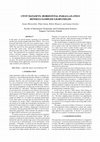Papers by Sergio Moreschini

2019 8th European Workshop on Visual Information Processing (EUVIP), 2019
Light fields representing Lambertian scenes are characterized by specific epipolar plane images, ... more Light fields representing Lambertian scenes are characterized by specific epipolar plane images, which support in Fourier domain is limited by the minimum and maximum scene depth. This feature of the light field has been taken into account when designing the shearlet-based light field reconstruction algorithm. However, this feature does not hold for the case of non-Lambertian scenes. Therefore, the original algorithm performs sub-optimally for such scenes. In this work, we extend the shearlet based reconstruction algorithm to enable light fields reconstruction for scenes composed of surfaces with non-Lambertian properties. Instead of assuming Lambertianity and the corresponding Fourier-domain support, we estimate the real Fourier-domain support of the given light field of a non-Lambertian scene. Based on the estimated support, we adapt the Shearlet frame to properly span that support. The results demonstrate that the new method yields a faithful reconstruction of densely sampled lig...

ArXiv, 2021
Background. Developers spend more time fixing bugs and refactoring the code to increase the maint... more Background. Developers spend more time fixing bugs and refactoring the code to increase the maintainability than developing new features. Researchers investigated the code quality impact on fault-proneness focusing on code smells and code metrics. Objective. We aim at advancing fault-inducing commit prediction based on SonarQube considering the contribution provided by each rule and metric. Method. We designed and conducted a case study among 33 Java projects analyzed with SonarQube and SZZ to identify fault-inducing and fault-fixing commits. Moreover, we investigated fault-proneness of each SonarQube rule and metric using Machine and Deep Learning models. Results. We analyzed 77,932 commits that contain 40,890 faults and infected by more than 174 SonarQube rules violated 1,9M times, on which there was calculated 24 software metrics available by the tool. Compared to machine learning models, deep learning provide a more accurate fault detection accuracy and allowed us to accurately ...

In this paper, we present datasets consisting of six horizontalparallax-only densely-sampled ligh... more In this paper, we present datasets consisting of six horizontalparallax-only densely-sampled light fields (DSLFs). Five of the presented light fields (LFs) have been captured using a camera attached to an in-house built motorized linear positioning system (LPS). The sixth LF has been generated in Blender by replicating the LPS’ camera setup. All LFs have undergone preand post-processing steps in order to mitigate capture-related distortions. The generated LFs are organized, based on their characteristics, into three categories: synthetic, Lambertian and nonLambertian LFs. All of them comply with the DSLF requirement, i.e. the maximum disparity between adjacent images is less than one pixel. The datasets are provided to serve as ground truth LFs for developing various applications, such as LF view interpolation, super resolution, and compression. Index Terms — light field, dataset, non-Lambertian, LPS
[Conclusion.] OSS selection can be partially automated, by extracting the information needed for ... more [Conclusion.] OSS selection can be partially automated, by extracting the information needed for the selection from portal APIs. OSS producers can benefit from our results by checking if they are providing all the information commonly required by potential adopters. Developers can benefit from our results, using the list of factors we selected as a checklist during the selection of OSS, or using the APIs we developed to automatically extract the data from OSS projects.

Integral or light field imaging is an attractive approach in microscopy, as it allows to capture ... more Integral or light field imaging is an attractive approach in microscopy, as it allows to capture 3D samples in just one shot and explore them later through changing the focus on particular depth planes of interest. However, it requires a compromise between spatial and angular resolution on the 2D sensor recording the microscopic images. A particular setting called Fourier Integral Microscope (FIMic) allows maximizing the spatial resolution for the cost of reducing the angular one. In this work, we propose a technique, which aims at reconstructing the continuous light field from sparse FIMic measurements, thus providing the functionality of continuous refocus on any arbitrary depth plane. Our main tool is the densely-sampled light field reconstruction in shearlet domain specifically tailored for the case of FIMic. The experiments demonstrate that the implemented technique yields better results compared to refocusing sparsely-sampled data.

Proceedings of the 4th ACM SIGSOFT International Workshop on Machine-Learning Techniques for Software-Quality Evaluation
Anomaly detection has been attracting interest from both the industry and the research community ... more Anomaly detection has been attracting interest from both the industry and the research community for many years, as the number of published papers and services adopted grew exponentially over the last decade. One of the reasons behind this is the wide adoption of cloud systems from the majority of players in multiple industries, such as online shopping, advertisement or remote computing. In this work we propose a Dataset foR cloud-nAtive memoRy anomaliEs: RARE. It includes labelled anomaly time-series data, comprising of over 900 unique metrics. This dataset has been generated using a microservice for injecting artificial byte stream in order to overload the nodes, provoking memory anomalies, which in some cases resulted in a crash. The system was built using a Kafka server deployed on a Kubernetes system. Moreover, in order to get access and download the metrics related to the server, we utilised Prometheus. In this paper we present a dataset that can be used coupled with machine learning algorithms for detecting anomalies in a cloud based system. The dataset will be available in the form of CSV file through an online repository. Moreover, we also included an example of application using a Random Forest algorithm for classifying the data as anomalous or not. The goal of the RARE dataset is to help in the development of more accurate and reliable machine learning methods for anomaly detection in cloud based systems.
2017 IEEE 22nd International Workshop on Computer Aided Modeling and Design of Communication Links and Networks (CAMAD), Jun 1, 2017
Real-time video delivery in Vehicle-to-Infrastructure (V2I) scenario enables a variety of multime... more Real-time video delivery in Vehicle-to-Infrastructure (V2I) scenario enables a variety of multimedia vehicular services. We conduct experiments with Dedicated Short Range Communications (DSRC) transceivers located in the mutual proximity and exchanging Skype video calls traffic. We demonstrate that the lack of coordination between the users both at the application as well as Medium Access Control (MAC) layers results in problems with quality of service provisioning even for the setup without vehicular mobility.

IFIP Advances in Information and Communication Technology
Open source software (OSS), playing an increasingly critical role nowadays, has been commonly ado... more Open source software (OSS), playing an increasingly critical role nowadays, has been commonly adopted and integrated in various software products. For many practitioners, selecting and adopting suitable OSS can help them greatly. Though many studies have been conducted on proposing OSS evaluation and selection models, a limited number are followed and used in the industry. Meanwhile, many existing OSS evaluation tools, though providing valuable details, fall short on offering intuitive suggestions in terms of framework-supported evaluation factors. Towards filling the gap, we propose an Open Source Software Project Evaluation and Selection TOol (OSS PESTO). Targeting OSS on Github, the largest OSS source code host, it facilitates the evaluation practice by enabling practitioners to compare candidates therein in terms of selected OSS evaluation models. It also allows in-time Github data collection and customized evaluation that enriches its effectiveness and ease of use.










Uploads
Papers by Sergio Moreschini